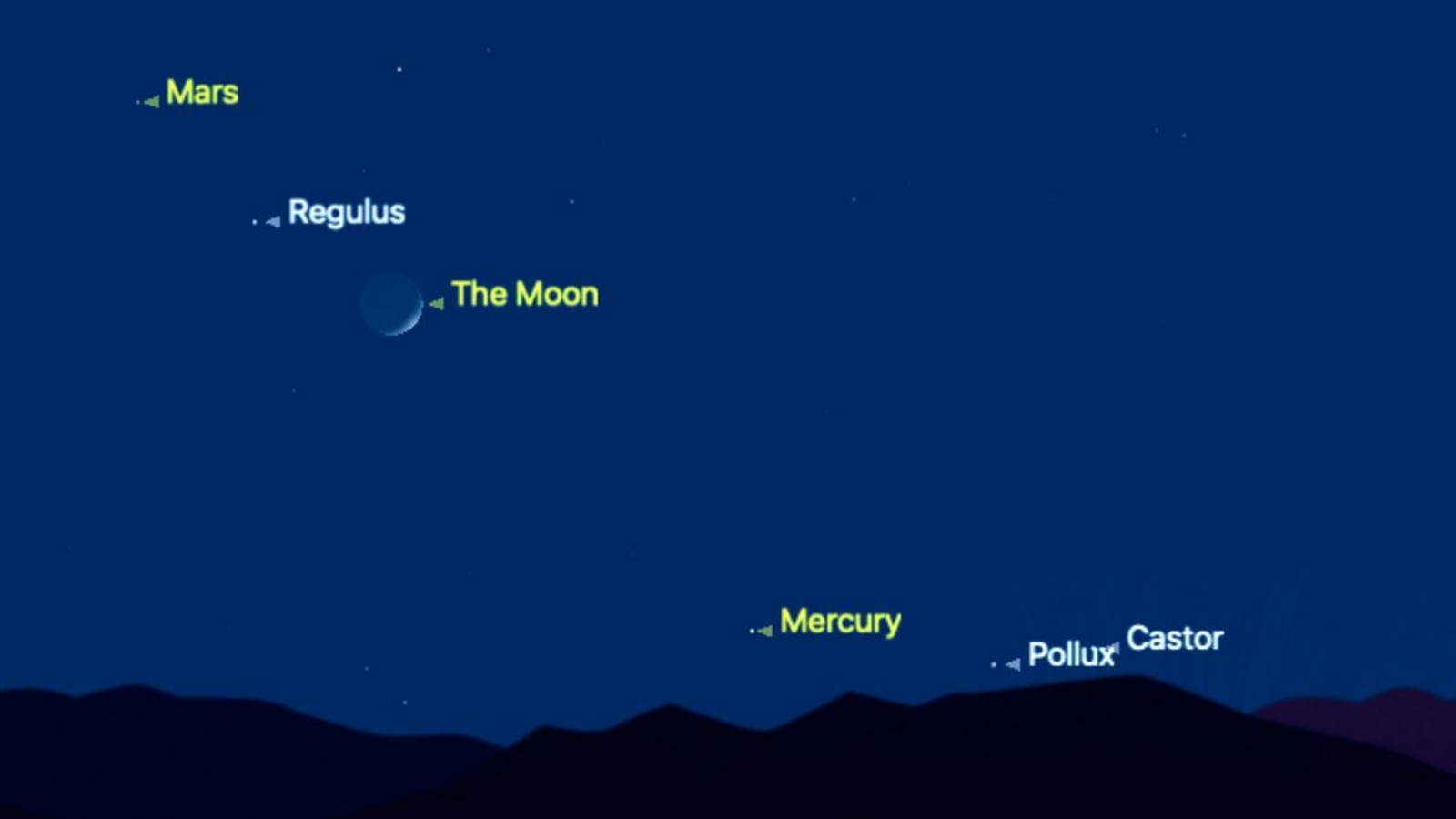Celestial Ballet: The Crescent Moon, Mars, and Regulus Illuminate the Night Sky

"Celestial Ballet: The Crescent Moon, Mars, and Regulus Illuminate the Night Sky"
As the sun dips below the horizon on the evening of June 28, a celestial performance begins to unfold in the western sky, captivating stargazers across the United States. The waxing crescent moon, a slender sliver of light, will take center stage in a cosmic dance with Mars and the bright star Regulus. This trio will align in a breathtaking spectacle that promises to enchant those who turn their gaze skyward.
At precisely sunset, the crescent moon will hover approximately 20 degrees above the western horizon, its delicate form a prelude to the night’s unfolding drama. As dusk deepens, Mars and Regulus will gradually emerge, positioning themselves to the upper left of the moon. This alignment, a fleeting yet mesmerizing display, will remain visible for only a few hours before following the sun’s path below the horizon. Enthusiasts are urged to seize this opportunity to witness the celestial alignment before it vanishes into the night.
The following evening, June 29, presents another act in this celestial ballet. The moon will gracefully transition to the lower right of Mars, appearing to sweep beneath the Red Planet. This close encounter, where the moon and Mars pass within a few degrees of each other, offers a glimpse of cosmic proximity before they too slip below the horizon.
For those eager to delve deeper into this astral event, the Celestron NexStar 4SE telescope comes highly recommended. Ideal for beginners, this telescope promises quality and reliability, bringing celestial objects like Mars, Regulus, and the moon into sharp focus. A detailed review of the Celestron NexStar 4SE can provide further insights for aspiring astronomers keen to explore the night sky.
In a captivating twist, some fortunate observers will witness the moon perform an occultation of Mars, where it passes directly in front of the planet, obscuring it from view. This rare phenomenon, made possible by the moon’s relative proximity to Earth, will be visible from select regions, including parts of Peru, Ecuador, Colombia, and Clipperton Island, shortly after 6:57 p.m. EDT (22:57 GMT) on June 29.
For those inspired to capture this celestial alignment, guides to the best cameras and lenses for astrophotography in 2025 are available. Additionally, a roundup of top telescopes and binoculars offers further resources for exploring the cosmos.
Space enthusiasts are encouraged to share their captures of this celestial event with Space.com’s readership. Photos, comments, and personal details can be sent to spacephotos@space.com, contributing to a shared appreciation of this astronomical wonder.
Stay informed with the Space.com Newsletter for breaking space news, updates on rocket launches, and upcoming skywatching events. Engage with a community of stargazers and explore the universe from the comfort of your own backyard.
🔮 Fortellr Predicts
Confidence: 85%
The celestial alignment involving the crescent moon, Mars, and Regulus is predicted to significantly boost public interest in astronomy and related fields over the forthcoming weeks. Similar historical events have demonstrated an increase in sales of optical equipment, particularly telescopes and astrophotography tools, and we can expect a parallel trend in this scenario. Given Amazon's dominating presence in e-commerce, and its historical response to market demands, it is likely that the company will capitalize on this interest by promoting astronomy-related products. Concurrently, educational institutions and online platforms focusing on astronomy are likely to experience heightened engagement, with increased enrollment in relevant courses or soaring hits on stargazing and space exploration content as individuals seek to deepen their understanding of celestial phenomena. In the context of current technological advancements, particularly in AI and digital platforms, we may also see the development of specialized apps or software that enable users to simulate or explore celestial events more interactively. Regionally, while the occultation of Mars is visible from specific areas in South America, local upticks in public astronomical observation activities are anticipated. These might be facilitated by local astronomical societies holding viewing events to capitalize on this unique opportunity. Such events will likely foster community engagement with astronomy and even lead to collaborations with educational or governmental organizations for public outreach initiatives centered around space science education.